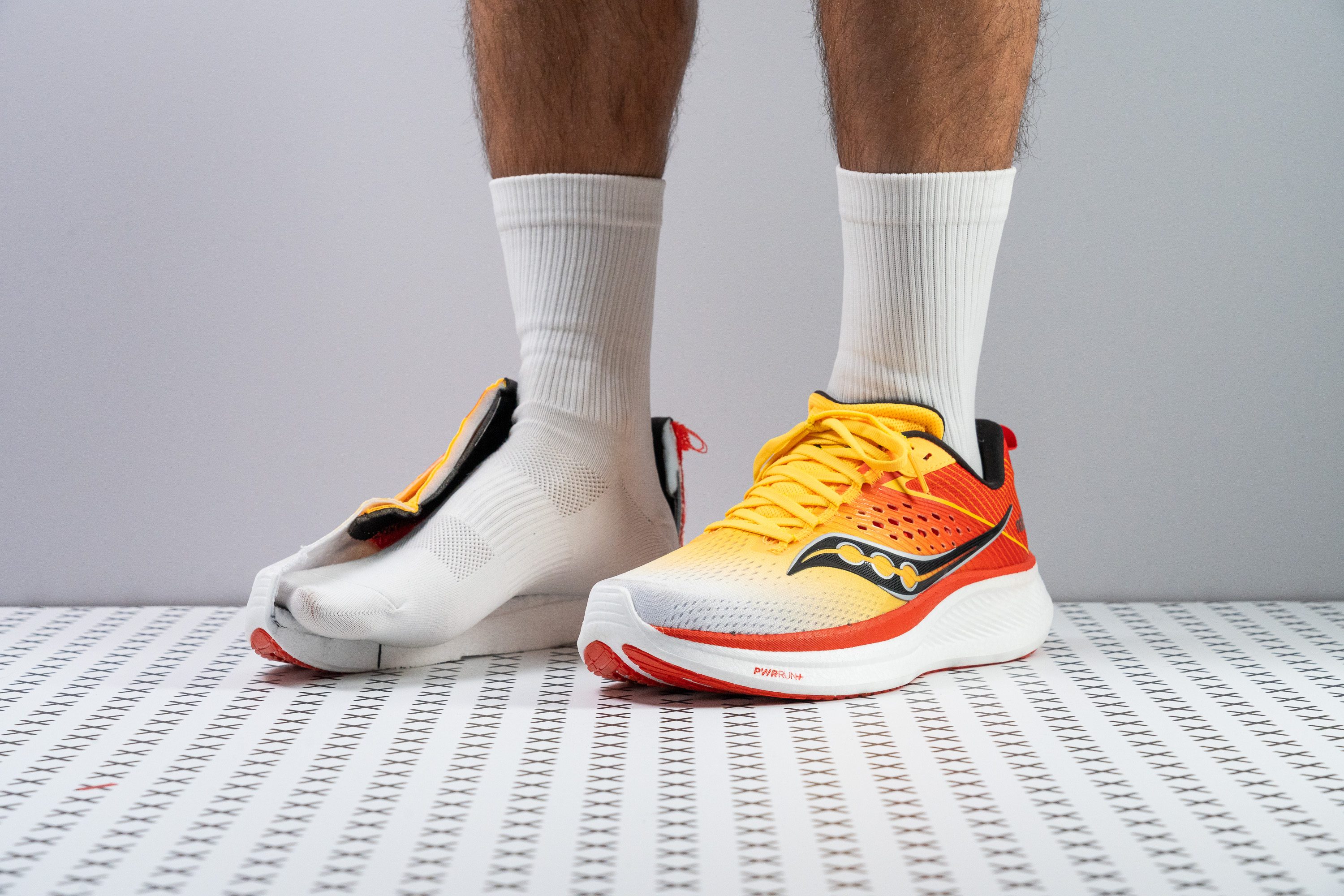Our verdict
- Top pick in best Saucony running shoes (2024)
- Top pick in best Saucony walking shoes (2024)
Pros
- Incredible value
- Most cushioned Ride yet
- High-volume upper
- Enhanced stability
- Upgraded PWRRUN+ midsole
- Best-in-class durability
- Superior lockdown
Cons
- Tapered toebox
- Subpar breathability
- Could be lighter
Audience verdict
- Top 24% in road running shoes
- Top 17% in Saucony running shoes
- Top 25% most popular running shoes
Comparison
The most similar running shoes compared
+ + Add a shoe | |||||
|---|---|---|---|---|---|
| Audience score | 89 Great! | 89 Great! | 89 Great! | 89 Great! | |
| Price | £135 | £130 | £170 | £130 | |
| Pace | Daily running | Daily running | Daily running | Daily running | |
| Shock absorption | Moderate | Moderate | High | High | |
| Energy return | - | Moderate | Moderate | - | |
| Traction | Moderate | Moderate | High | High | |
| Arch support | Neutral | Neutral | Neutral | Neutral | |
| Weight lab Weight brand | 10.2 oz / 288g 9.9 oz / 282g | 10.1 oz / 285g 9.8 oz / 277g | 10.3 oz / 292g 10.4 oz / 295g | 9 oz / 255g 9.5 oz / 269g | |
| Drop lab Drop brand | 8.5 mm 8.0 mm | 7.0 mm 6.0 mm | 6.6 mm 6.0 mm | 8.4 mm 8.0 mm | |
| Strike pattern | HeelMid/forefoot | HeelMid/forefoot | Mid/forefoot | HeelMid/forefoot | |
| Size | True to size | True to size | Slightly large | True to size | |
| Midsole softness | Soft | Balanced | Balanced | Balanced | |
| Difference in midsole softness in cold | Small | Normal | Small | Small | |
| Toebox durability | Decent | Decent | Good | Decent | |
| Heel padding durability | Good | Decent | Decent | Good | |
| Outsole durability | Good | Bad | Good | Good | |
| Breathability | Warm | Moderate | Warm | Breathable | |
| Width / fit | Medium | Medium | Wide | Medium | |
| Toebox width | Medium | Medium | Medium | Medium | |
| Stiffness | Moderate | Moderate | Stiff | Moderate | |
| Torsional rigidity | Moderate | Moderate | Moderate | Flexible | |
| Heel counter stiffness | Moderate | Moderate | Moderate | Flexible | |
| Rocker | ✓ | ✓ | ✓ | ✗ | |
| Heel lab Heel brand | 35.1 mm 35.0 mm | 36.8 mm 31.0 mm | 37.9 mm 35.0 mm | 35.0 mm 37.0 mm | |
| Forefoot lab Forefoot brand | 26.6 mm 27.0 mm | 29.8 mm 25.0 mm | 31.3 mm 29.0 mm | 26.6 mm 29.0 mm | |
| Widths available | NormalWide | Normal | Normal | NormalWide | |
| Orthotic friendly | ✓ | ✓ | ✓ | ✓ | |
| Season | All seasons | All seasons | All seasons | SummerAll seasons | |
| Removable insole | ✓ | ✓ | ✓ | ✓ | |
| Ranking | #141 Top 22% | #86 Top 24% | #98 Top 27% | #100 Top 27% | |
| Popularity | #160 Top 25% | #257 Bottom 31% | #36 Top 10% | #51 Top 14% |
Who should buy
We're convinced the Saucony Ride 17 is a top pick for:
- Runners in search of a reliable daily trainer known for its exceptional durability and performance across various distances.
- Loyal fans of the Ride series eager to experience the latest version's enhanced, more responsive midsole for a bouncier feel with every stride.
- Those who prefer a neutral running shoe with a high-volume upper.
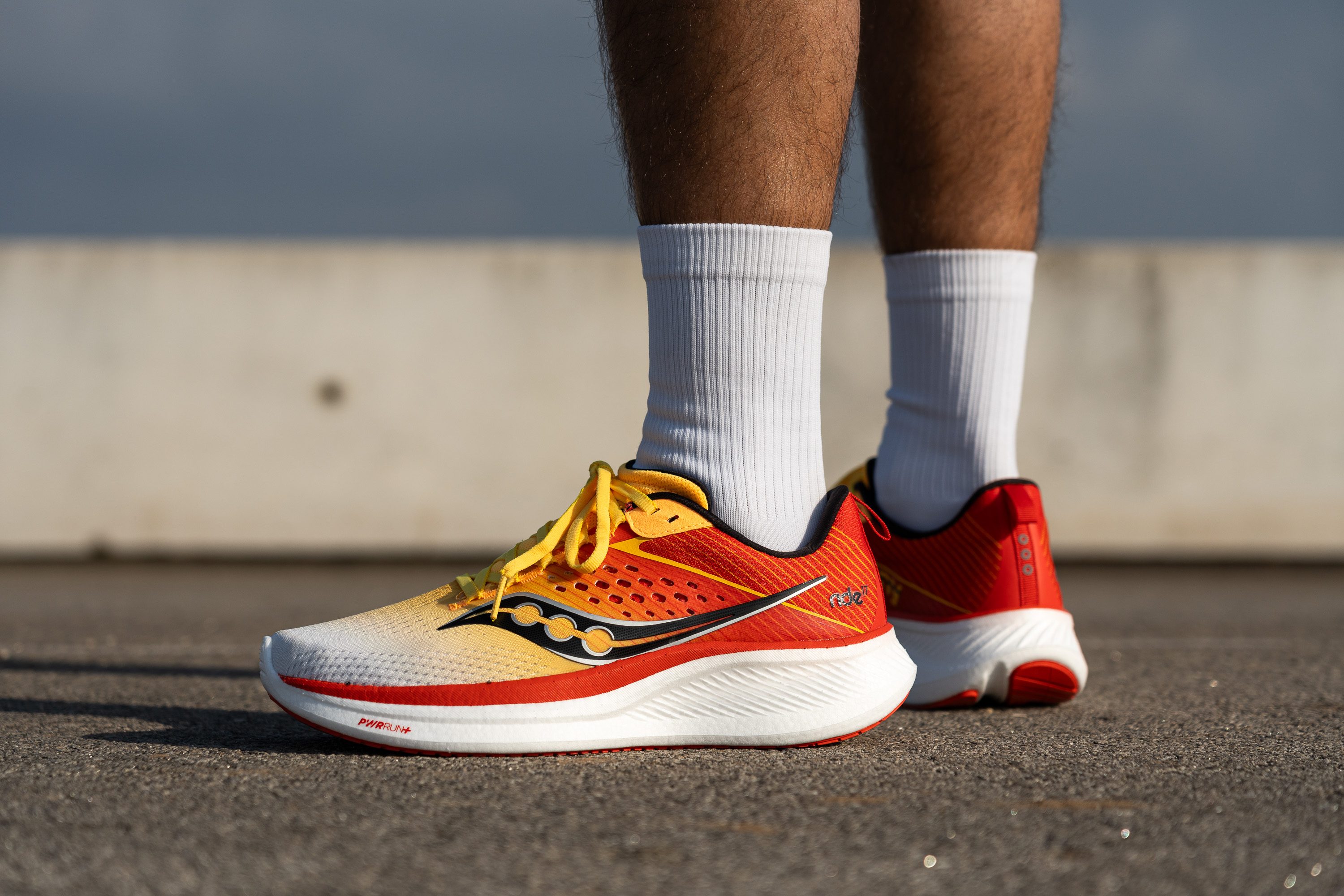
Who should NOT buy
While the Saucony Ride 17 stands out as an exceptional daily workhorse for racking up the miles, we've concluded that it doesn't excel in breathability. This becomes a significant drawback for those who frequently run in hot weather.
We highly recommend considering an alternative daily trainer with better ventilation, such as the Brooks Ghost Max or the ASICS Novablast 4, for those warmer runs.
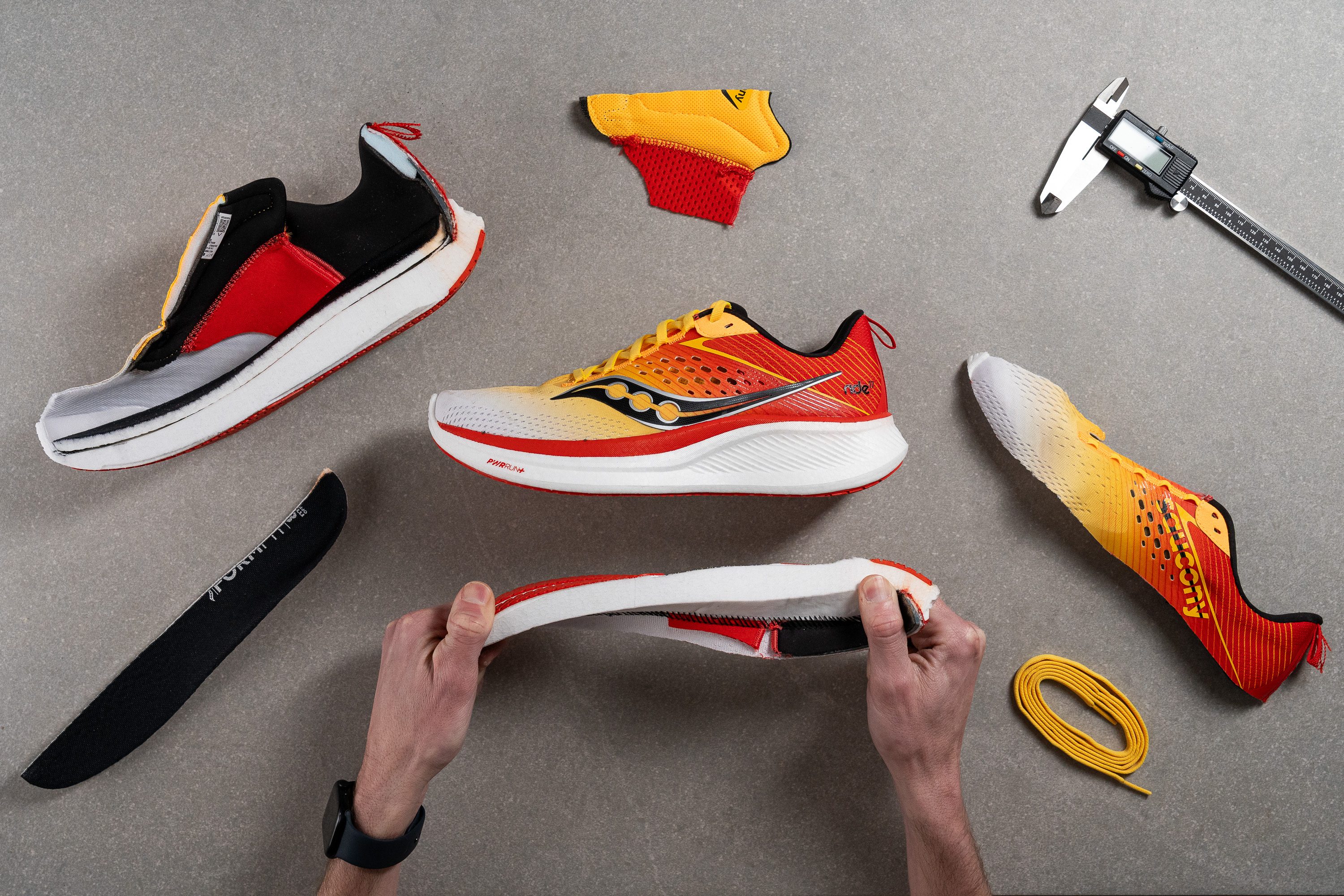
Moreover, although the Ride 17 offers a great level of cushioning, it may not satisfy runners seeking a maximalist shoe. For those desiring a daily trainer with even more cushioning, we believe the ASICS Nimbus 26 would be a more fitting choice.
Cushioning
Shock absorption
The Ride 17 stays true to its roots as a classic, no-frills running shoe, so we weren’t surprised to find average shock absorption.
It almost feels like Saucony plays it safe year after year, delivering a safe design that won’t divide opinions. The 122 SA result confirms that approach perfectly.

| Ride 17 | 122 SA |
| Average | 129 SA |
Heel stack
The primary factor behind the weight increase from previous versions is the increased stack height.
The Ride 17 boasts a heel stack of 35.1mm, which is 1.8 mm taller than its predecessor, earning our seal of approval for heel strikers.
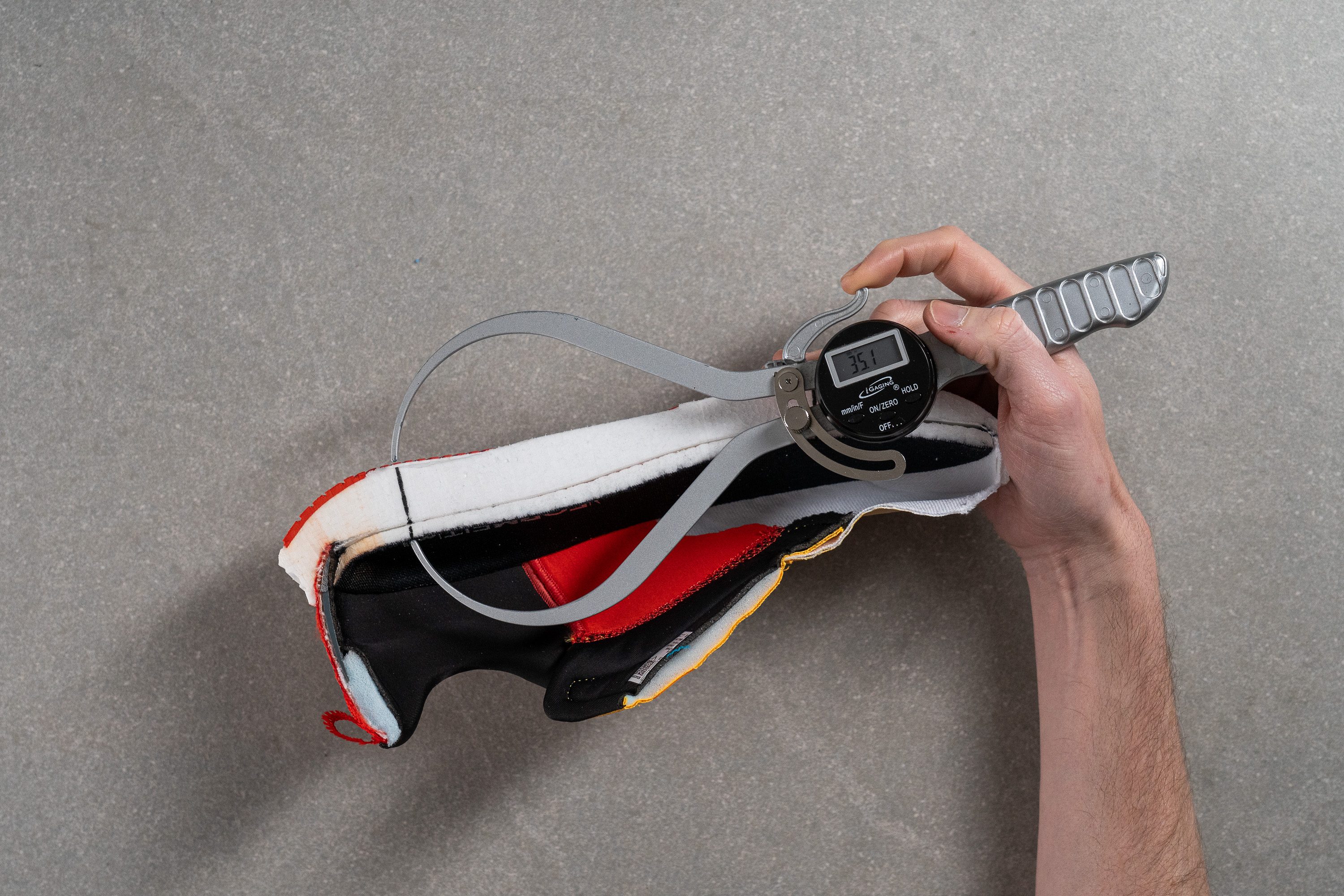
| Ride 17 | 35.1 mm |
| Average | 34.8 mm |
Forefoot stack
We measured the forefoot stack as well, clocking in at 26.6 mm with our digital calliper. Just like the heel, the Ride 17's forefoot is slightly thicker than its predecessors, aligning with current trends.
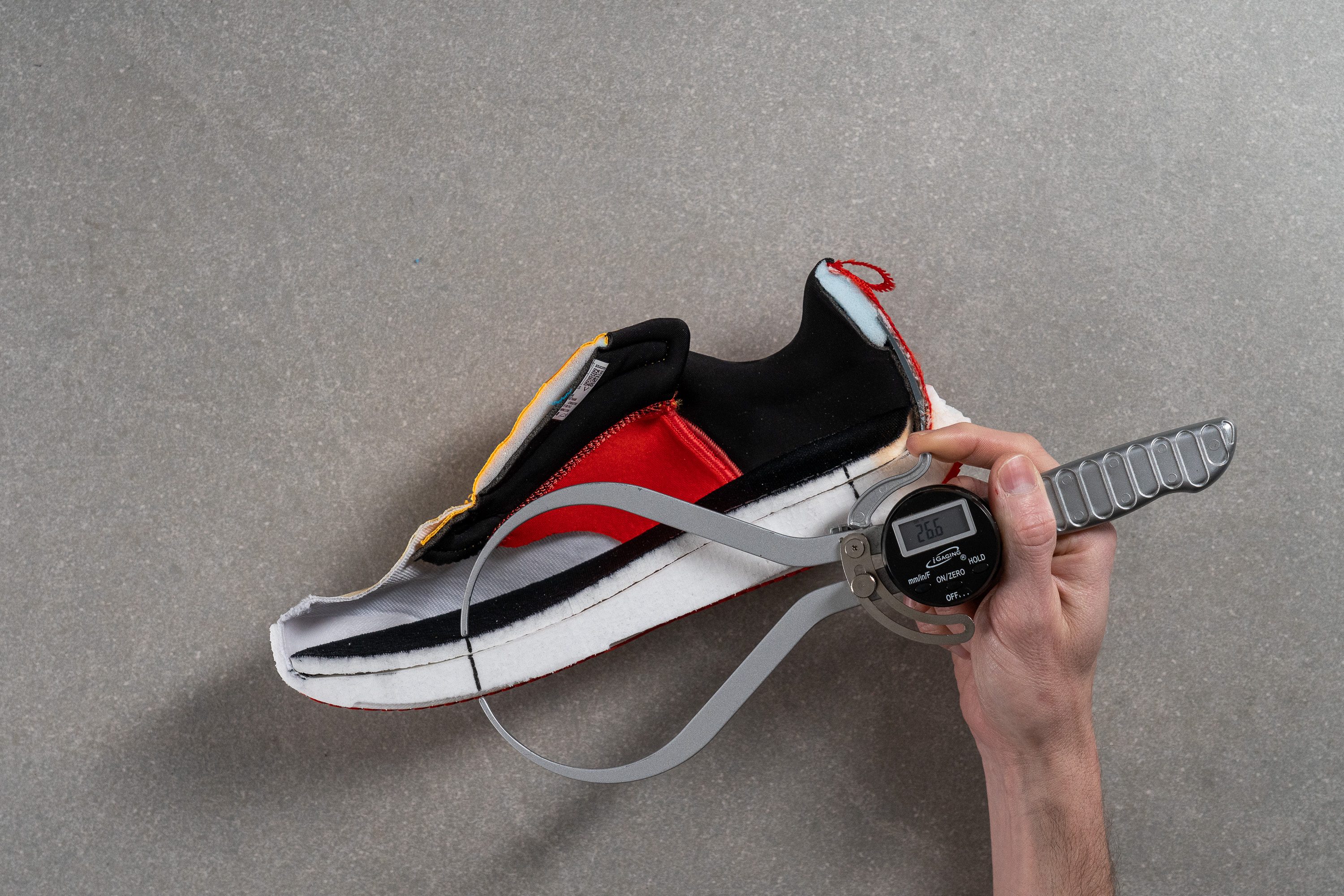
| Ride 17 | 26.6 mm |
| Average | 26.2 mm |
Drop
Saucony claims an 8-mm heel-to-toe drop for the Ride 17—a standard feature throughout the series and the most common offset in daily trainers. Following the official guidelines from World Athletics, we clocked an 8.5-mm drop, which is super close.
An 8.5-mm drop suggests the shoe suits a wide range of runners, making it versatile for various footstrikes. However, we believe that forefoot strikers might find a shoe with a lower drop, such as the Hoka Clifton 9, more to their liking.

| Ride 17 | 8.5 mm |
| Average | 8.6 mm |
Midsole softness
The midsole showcases the most significant update in this shoe compared to previous versions.
Saucony swapped the PWRRUN compound for the more resilient and softer PWRRUN+, enhancing the TPU formula across various aspects while retaining all the positive attributes of its predecessor.
Our durometer reading of 19.0 HA indicates a balanced approach that offers a moderately soft ride. This sensation is amplified underfoot by the thick insole, making it feel even softer than anticipated.

| Ride 17 | 19.0 HA |
| Average | 20.4 HA |
Size and fit
Size
Saucony Ride 17 fits true to size (79 votes).
Width / Fit
The Ride is Saucony’s workhorse, so we weren’t surprised when our gel mould solidified in the freezer and measured 96.9 mm. This measurement places it slightly above the average.
In our view, this reflects the same balanced approach most brands take with daily trainers—designing them to cater to as many runners as possible. And for now, the Ride’s fit strikes a versatile balance too.
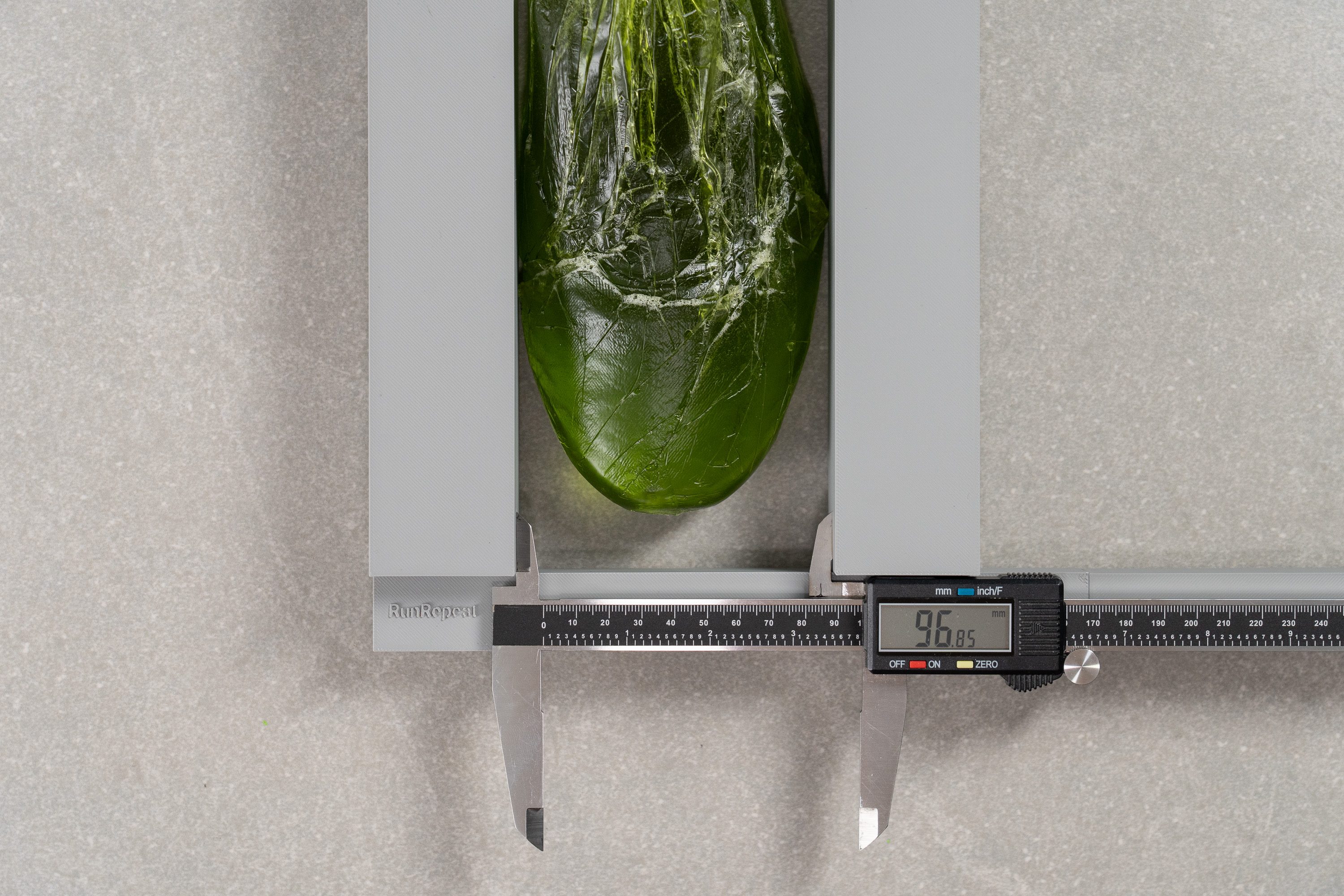
| Ride 17 | 96.9 mm |
| Average | 95.1 mm |
Toebox width
However, the front of the shoe tapers more than usual—a detail we noticed immediately when we pulled the gel cast out of the shoe. Its shape is far from resembling most human feet, and our 71.4 mm measurement confirms this.
Based on our findings, this shoe is better suited for runners with narrow feet in the front section, as its pointy shape offers limited space for broader toes.
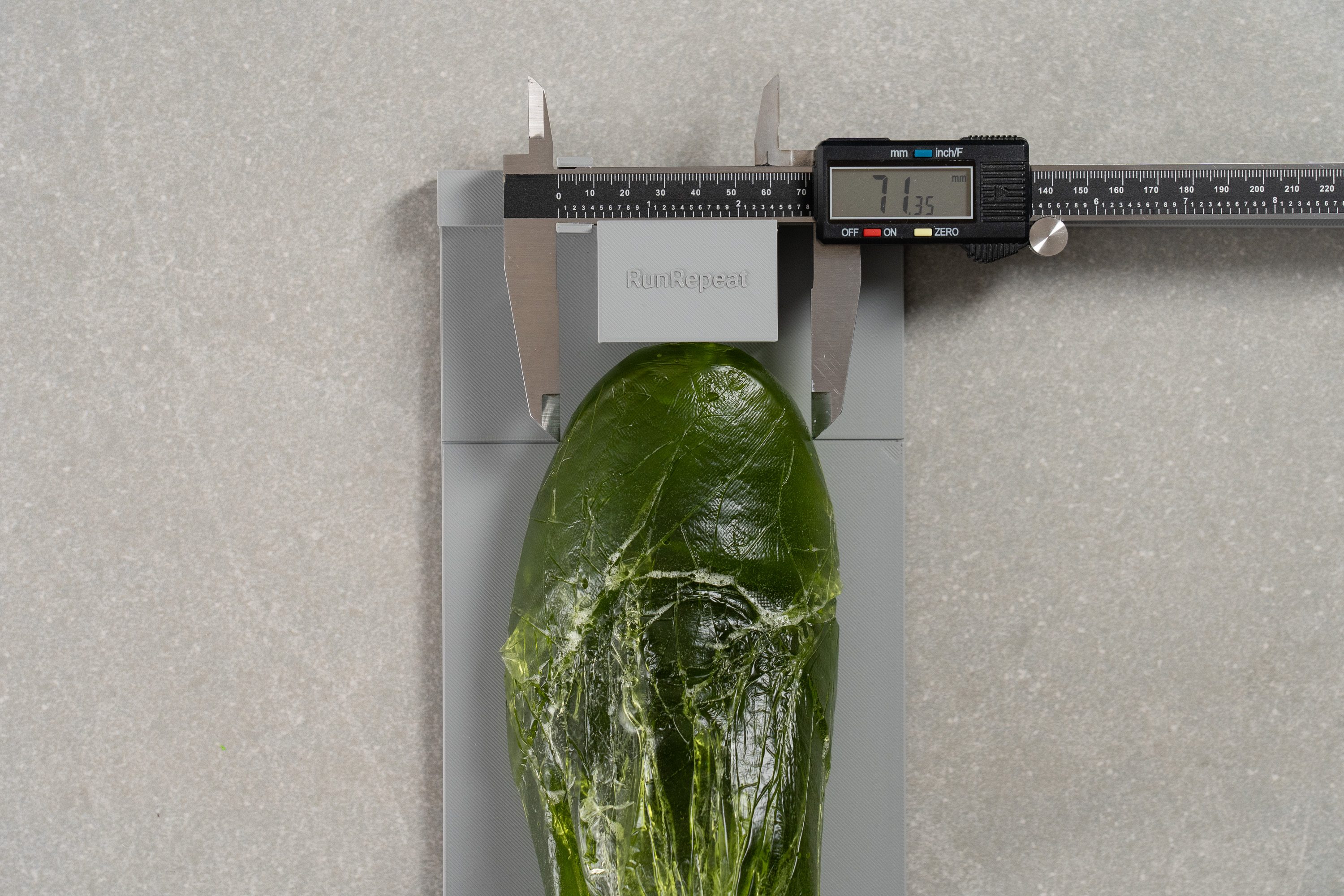
| Ride 17 | 71.4 mm |
| Average | 73.2 mm |
Toebox height
We also found that, while the toe area lacks horizontal space, the vertical clearance tells a different story. At 29.1 mm, it offers more upward room for toe movement than most competitors.
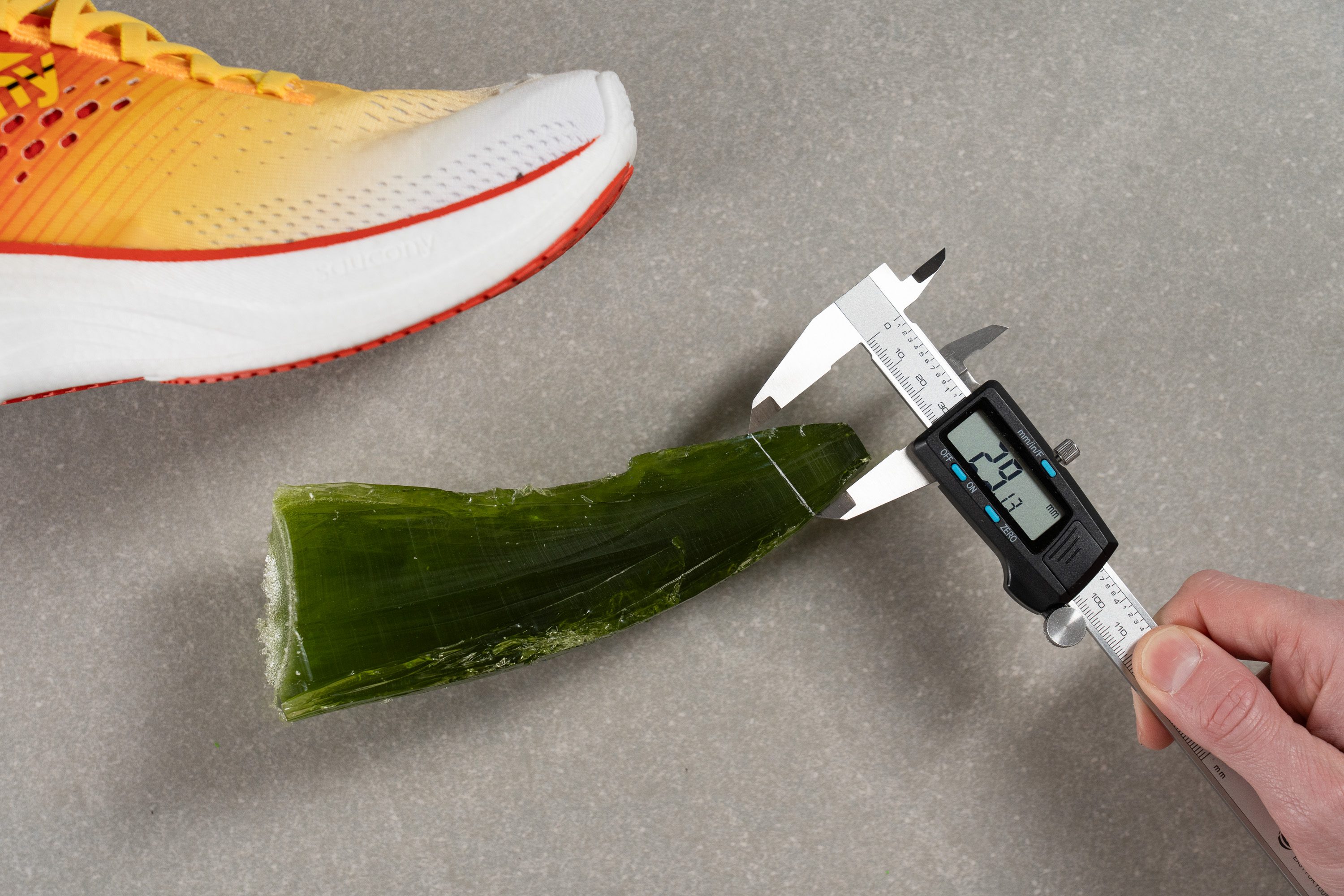
| Ride 17 | 29.1 mm |
| Average | 27.1 mm |
Traction / Grip
Traction test
We tested the outsole and recorded a 0.40 score—enough to deliver stable footing in rainy conditions, though we believe there’s still space for improvement in slippery conditions. Dry performance, on the other hand, feels really secure.
| Ride 17 | 0.40 |
| Average | 0.48 |
Outsole design
The outsole of the Ride 17 features multiple deep cutouts and wide exposed areas of foam through the midfoot and forefoot, all designed to trim down weight. Strategically placed rubber segments frame these voids, creating a lightweight yet structured layout that prioritises efficiency without compromising too much on durability.
We’re also not too worried about the exposed foam—based on our experience, every compound in the PWRRUN family handles pavement wear remarkably well and resists abrasion better than most other foams in the market.
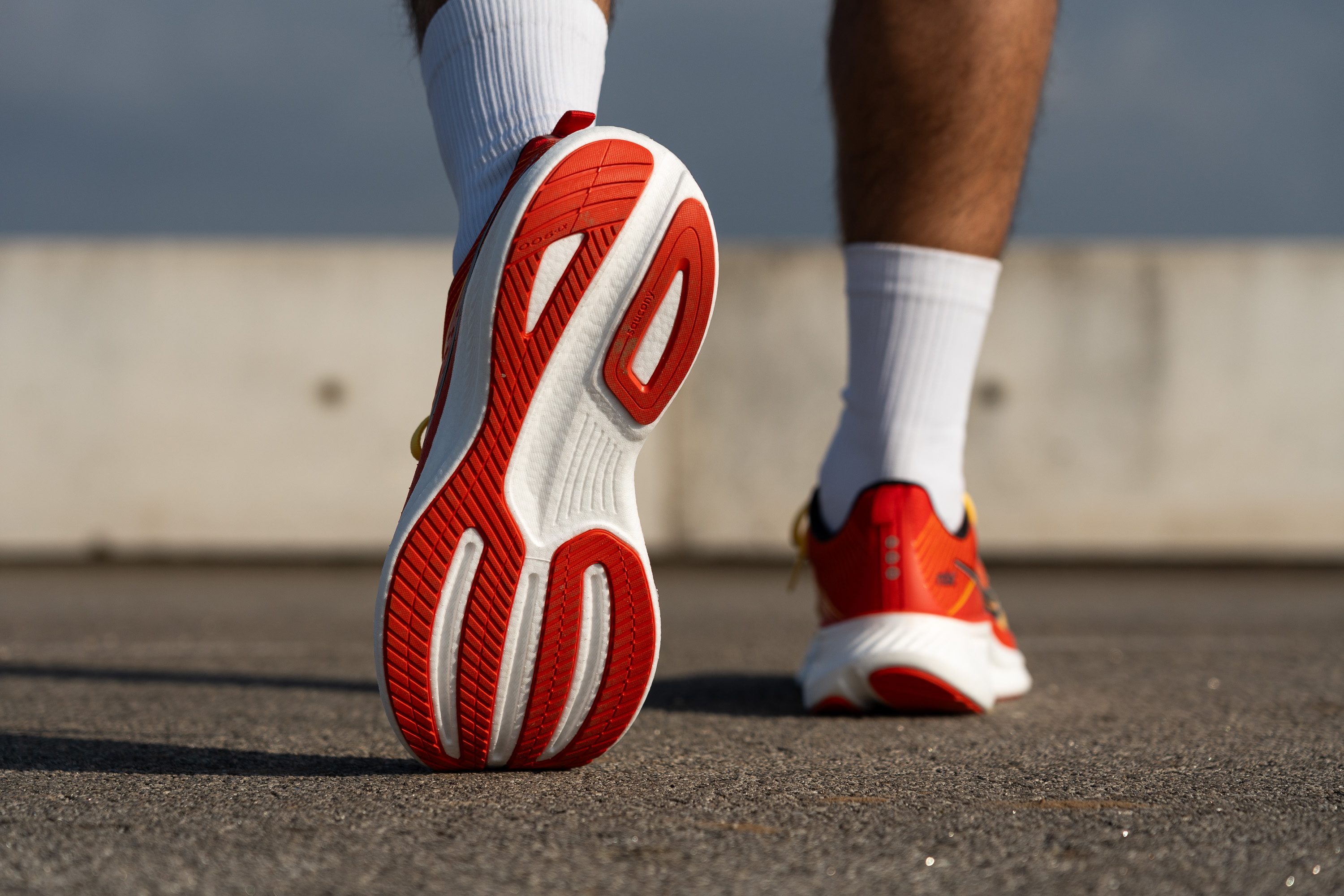
Flexibility / Stiffness
Even with the added stack height, the Ride 17 maintained a healthy level of flexibility. We measured 13.6N in our 30-degree bend test—a strong mid-range result that makes it adaptable enough for everything from casual running to everyday gym use.

| Ride 17 | 13.6N |
| Average | 15.3N |
Stiffness in cold (%)
Repeating the procedure we used on the midsole—measuring stiffness after a 20-minute freezer session—we found it only became 3.1% stiffer.
This is an absolutely delightful outcome, only possible because of the fantastic PWRRUN+ midsole. Unlike EVA, TPU works wonders in cold temperatures.
| Ride 17 | 3% |
| Average | 33% |
Weight
The Ride 17 isn't particularly heavy, nor is it featherlight—it comfortably occupies the middle ground, slightly tipping the scales above the 10-oz benchmark at 10.2 oz (288g) although it's 0.9 oz heavier than the Ride 16.
Yet, with daily trainers trending lighter in recent years, we believe Saucony should aim to trim at least one ounce off this model for the next version.

| Ride 17 | 10.2 oz (288g) |
| Average | 9.3 oz (264g) |
Breathability
The Saucony Ride 17's upper might look highly breathable at first glance, but in the lab, we prefer concrete evidence over assumptions. And launching into our analysis with a smoke test, the results were pretty disappointing.
Contrary to our expectations, the smoke test revealed the Ride 17's breathability to be lacklustre at 2/5. Despite its large ventilation holes, smoke evacuation was minimal, especially in the toebox. This was a stark contrast to the performance of the Saucony Triumph 20.
Our light test showed plenty of holes, yet it seemed like the smoke couldn't reach or escape through them. We were determined to uncover the reason.
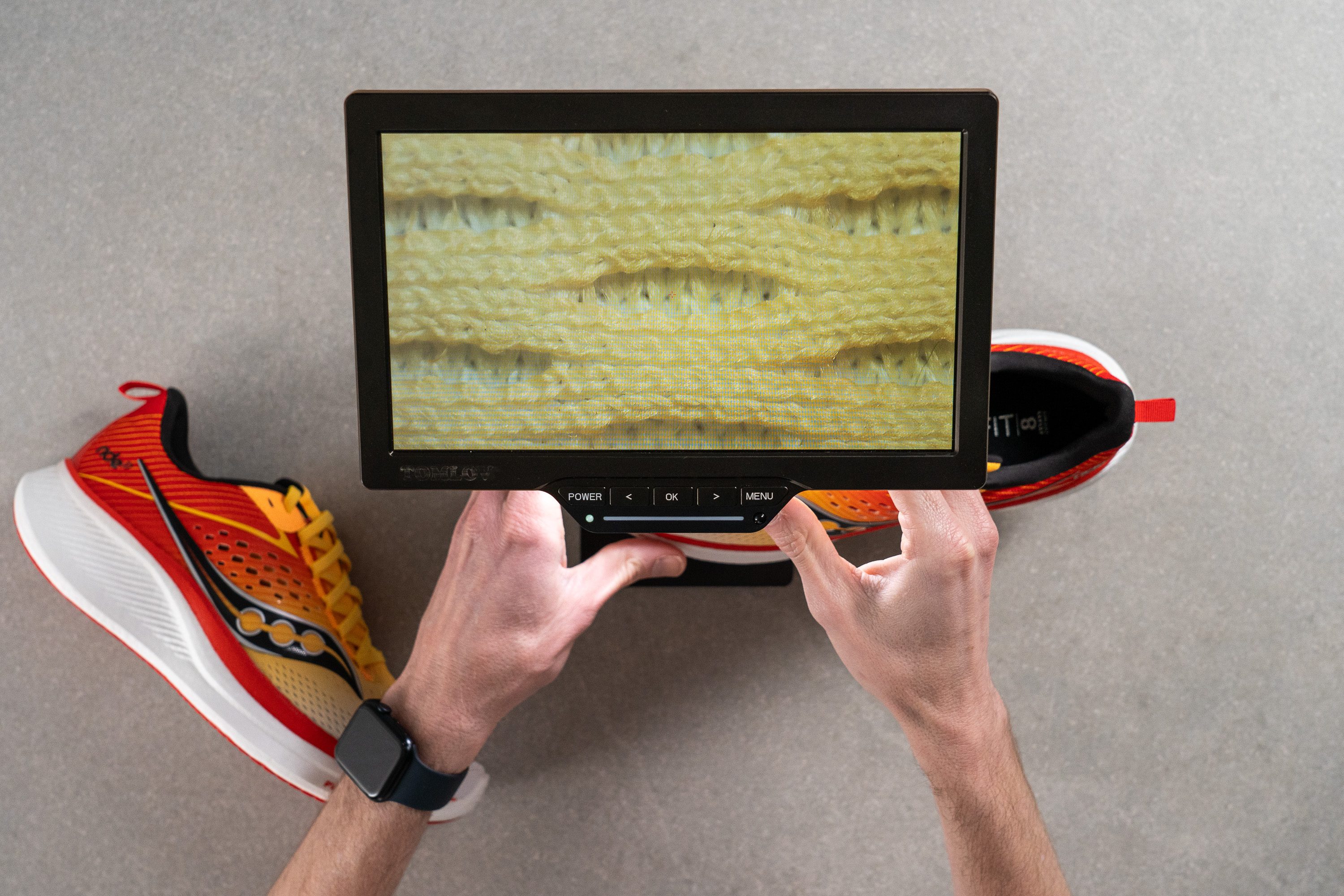
Under the microscope, we found the first piece of the puzzle. The holes were visible, but an underlying layer blocked airflow.

Our hands-on examination provided the definitive proof. An inner layer, designed for comfort in the toebox, ended up compromising breathability significantly by lacking ventilation holes.
We believe Saucony should consider matching the ventilation of this layer to the outer, as other brands successfully do even in cheaper shoes.
| Ride 17 | 2 |
| Average | 3.7 |
Stability
Lateral stability test
While the Ride 17 doesn't venture into stability shoe territory—leave that to the Saucony Tempus—we discovered that it offers a stable ride for neutral runners, a noteworthy feat considering its midsole is significantly softer than that of its predecessor. Let's find out why.
Torsional rigidity
The key to the enhanced stability in the Ride 17 lies in its increased rigidity. Unlike the Ride 16, which was highly flexible with a 1/5 score in our rigidity test, the Ride 17 achieved a 3/5—indicating a stiffer build.
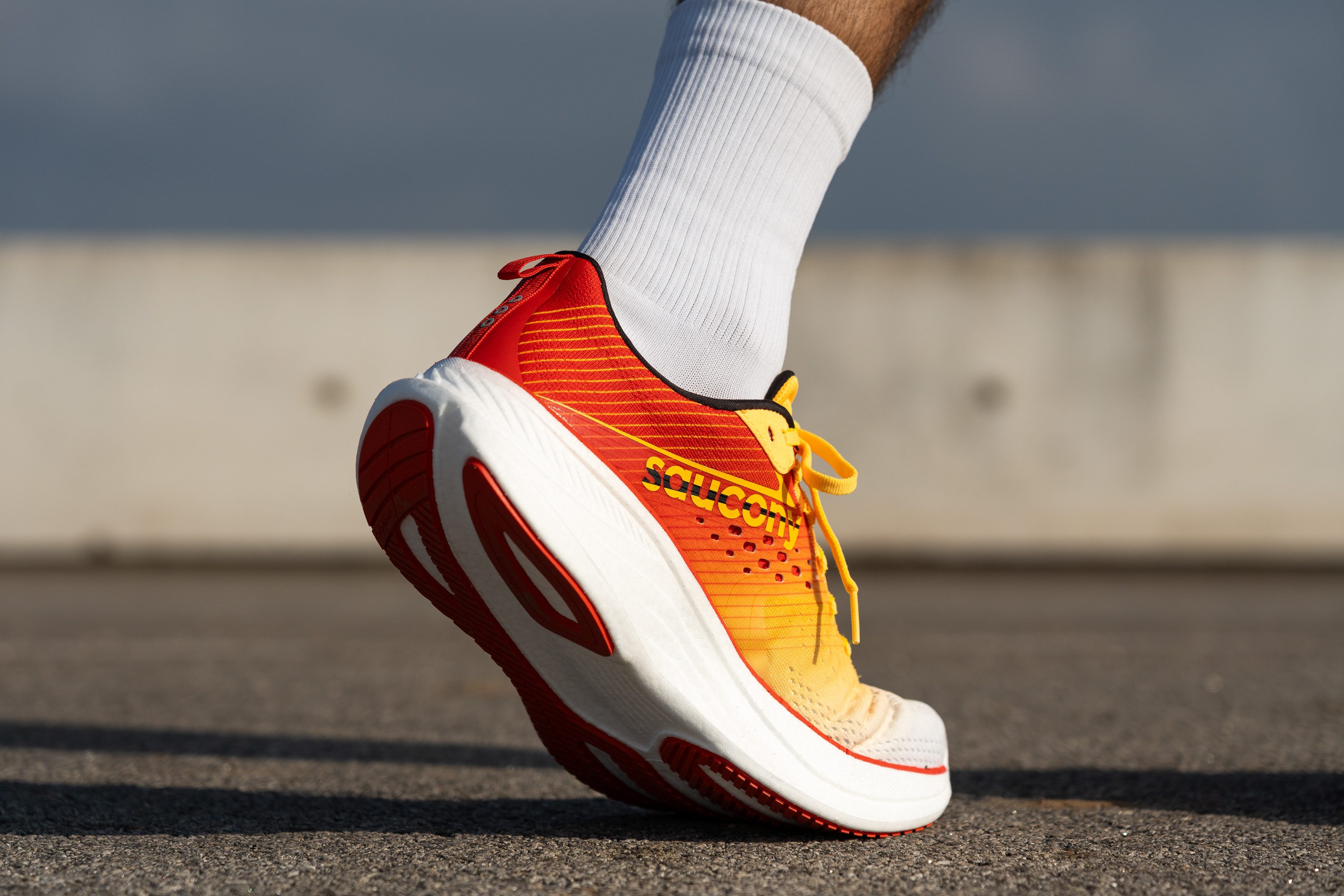
This stiffer construction translates to added stability and a more secure feel with each stride. However, this rigidity comes at a cost, making the shoe feel less natural and somewhat compromising the comfortable ride experienced in previous models. It's a classic trade-off scenario where you can't enjoy the best of both worlds.
| Ride 17 | 3 |
| Average | 3.5 |
Heel counter stiffness
The heel counter is just average (3/5), aligning with our expectations for a shoe designed to perform well across a broad spectrum of paces and distances.
| Ride 17 | 3 |
| Average | 2.9 |
Midsole width - forefoot
From the moment we got our hands on the Ride 17 in the lab and took it for a spin, we sensed its substantial size, particularly in the forefoot. Our surprise was palpable when our callipers showed a 125.1mm reading—dimensions you'd expect from stability shoes, not a neutral daily trainer.
This wiiide sole results in an incredibly stable ride for midfoot and forefoot strikers. However, it does lend the shoe a somewhat bulky feel, especially when taking corners.
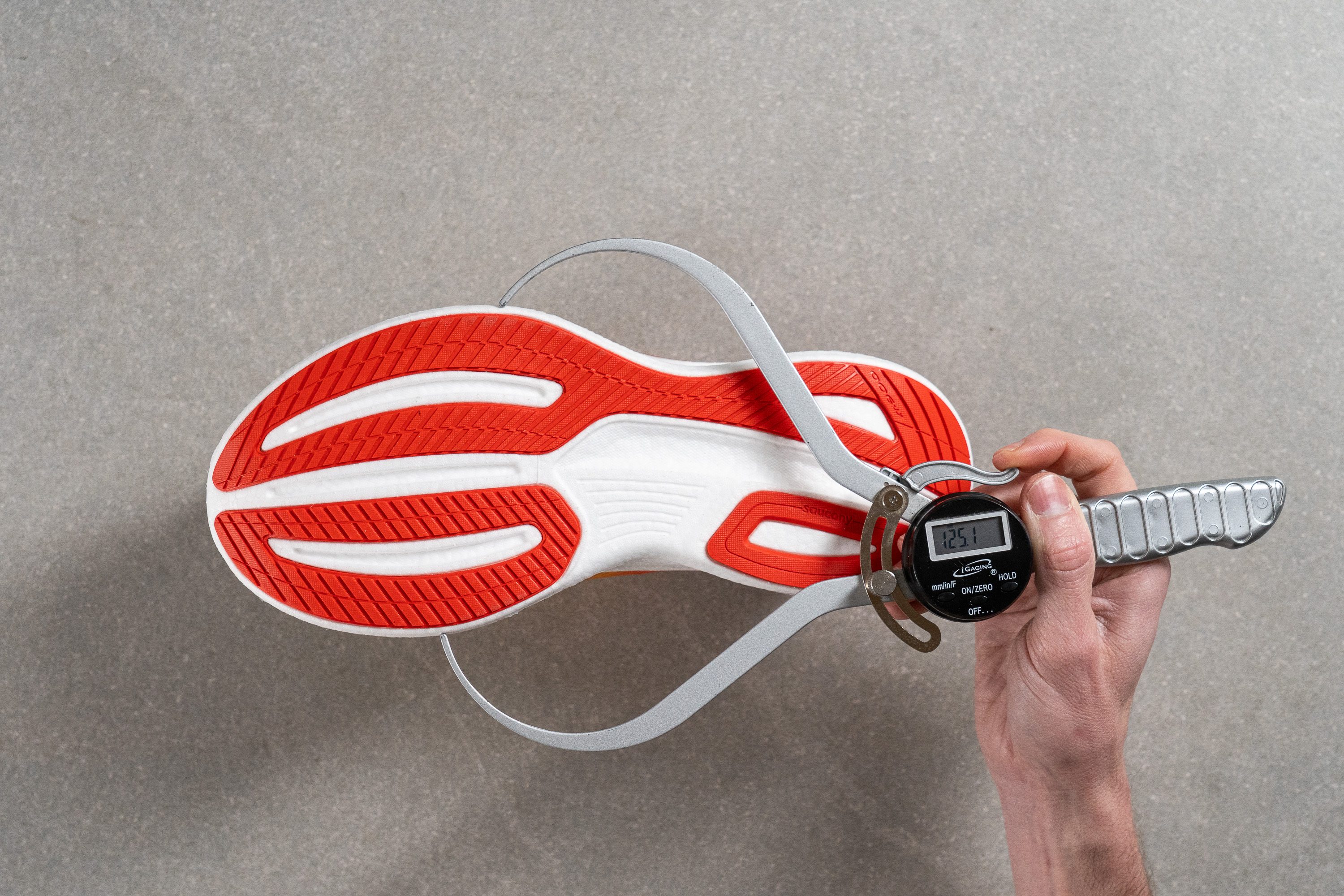
| Ride 17 | 125.1 mm |
| Average | 114.4 mm |
Midsole width - heel
The heel diverges from the forefoot's design, offering a slightly wider base at 93.8mm than what's typically seen in daily mileage workhorses. Consequently, rearfoot strikers might discover enhanced stability in this model compared to its rivals.

| Ride 17 | 93.8 mm |
| Average | 90.7 mm |
Durability
Toebox durability
Our second test focused on the durability of the engineered mesh upper rather than ventilation.
While the outer layer seemed less robust, the same inner fabric that hindered ventilation some minutes ago impressively maintained the upper's structure. In our Dremel test, this resulted in a solid 3/5 score.
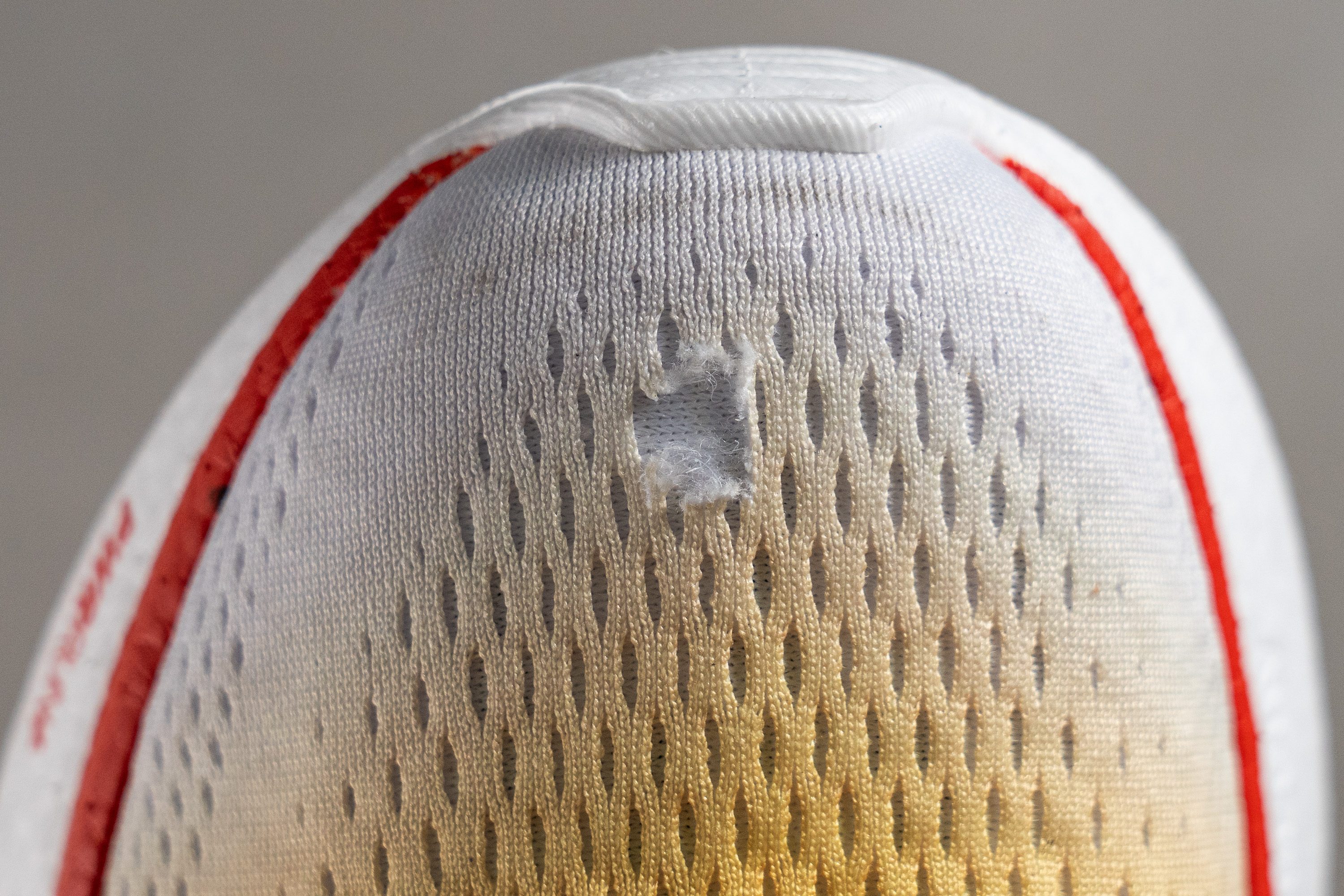
| Ride 17 | 3 |
| Average | 2.6 |
Heel padding durability
Transitioning to the heel padding area, our manual assessment led us to anticipate superior performance.
Fortunately, our expectations were met—the Ride 17 impressively scored 4/5 in this test. This is excellent news, offering every runner reassurance about the durability in the Achilles area.

| Ride 17 | 4 |
| Average | 3.4 |
Outsole hardness
Shifting our focus to the outsole, we were eager to see if the Ride 17 would maintain the positive momentum from the initial tests.

Before firing up the Dremel once more, we assessed the outsole's hardness. On our Shore C Durometer, it registered at 86.0 HC—significantly firm, indicating Saucony's intent to ensure outstanding durability. We were curious to see if this would indeed be the case.
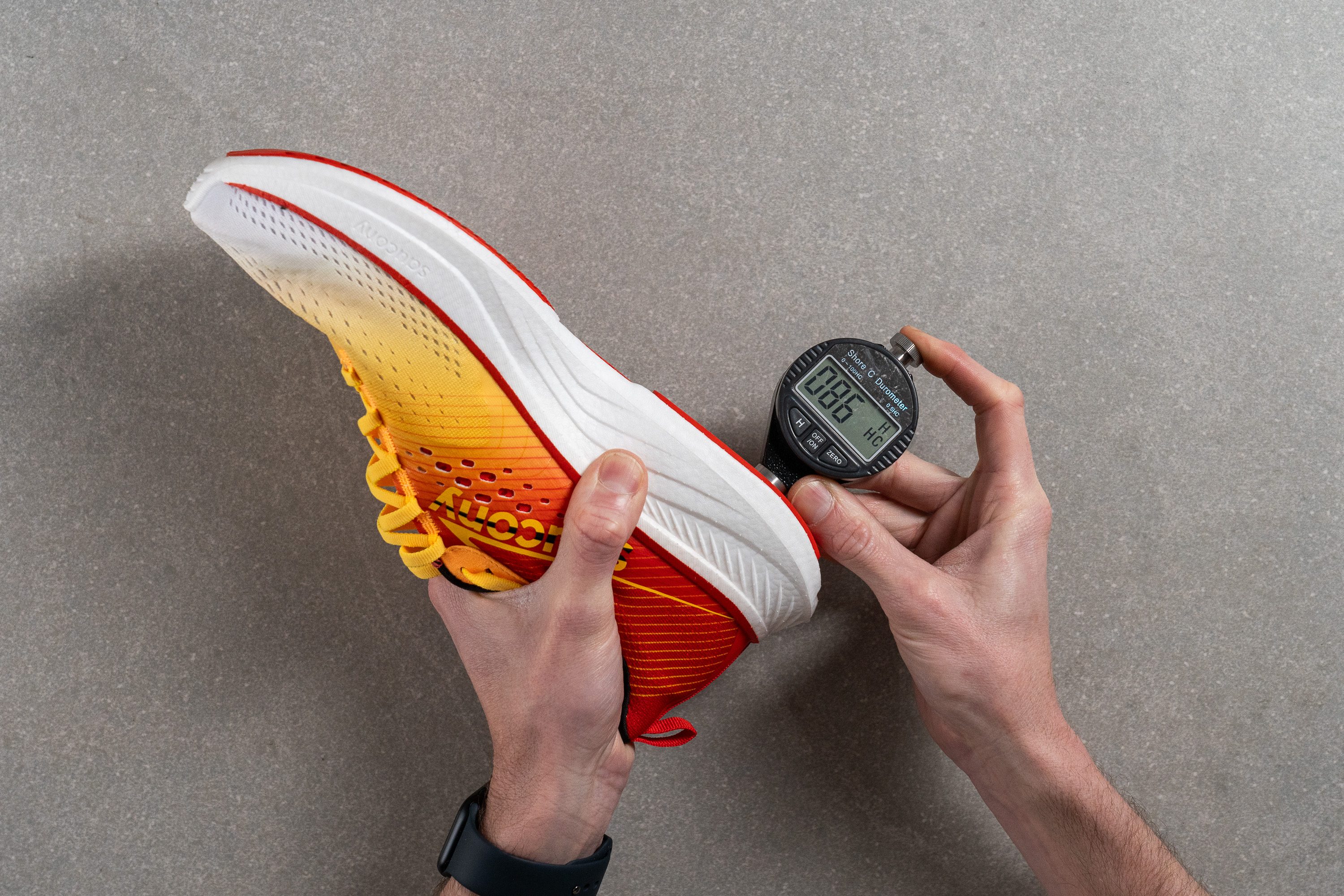
| Ride 17 | 86.0 HC |
| Average | 79.2 HC |
Outsole durability
Our final Dremel test was the most intense yet, fitting given the hard rubber we were examining.
Upon measuring the indentation left by the tool, we were thrilled. The Dremel barely made a dent, removing just 0.3mm of foam—yet another proof to the Ride 17's jaw-dropping durability.

| Ride 17 | 0.3 mm |
| Average | 1.1 mm |
Outsole thickness
We still had to gauge the outsole's thickness, which stood at 3.4mm.

Given the impressive durability of the Ride 17's outsole, we're convinced that a reduction to 2 or 2.5mm could shave off some weight without risking premature wear.
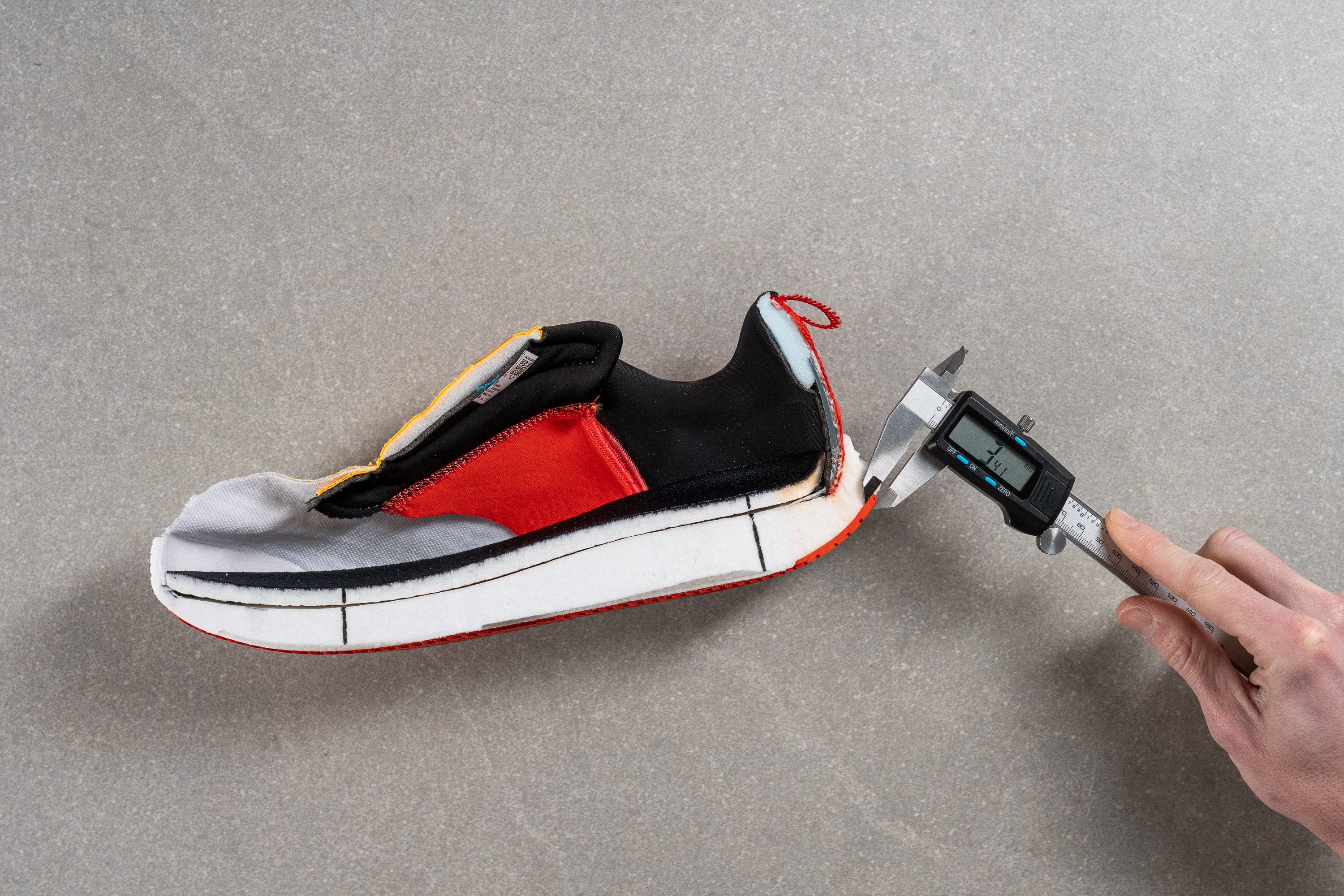
| Ride 17 | 3.4 mm |
| Average | 3.2 mm |
Misc
Insole thickness
The insole is exceptionally cushioned, surpassing last year's Ride model with a plush 6.7 mm thickness measured on our durometer. True to Saucony's heritage, this isn't just any ordinary insole—it's exceptionally soft, ensuring a comfortable ride.

| Ride 17 | 6.7 mm |
| Average | 4.5 mm |
Removable insole
We discovered that the insole isn't glued to the midsole and is completely removable. This makes swapping it out hassle-free, especially given its standard shape.
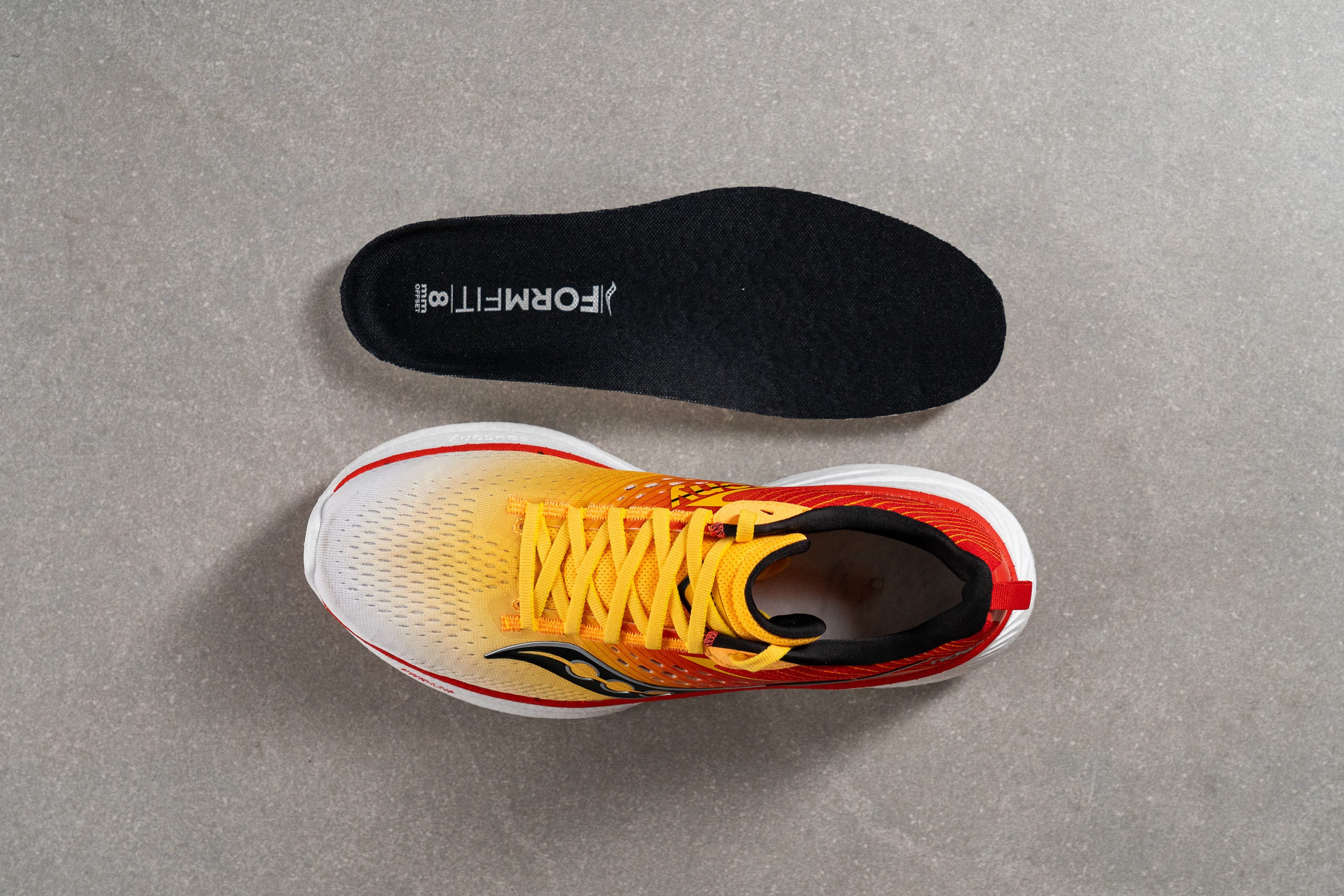
| Ride 17 | Yes |
Midsole softness in cold
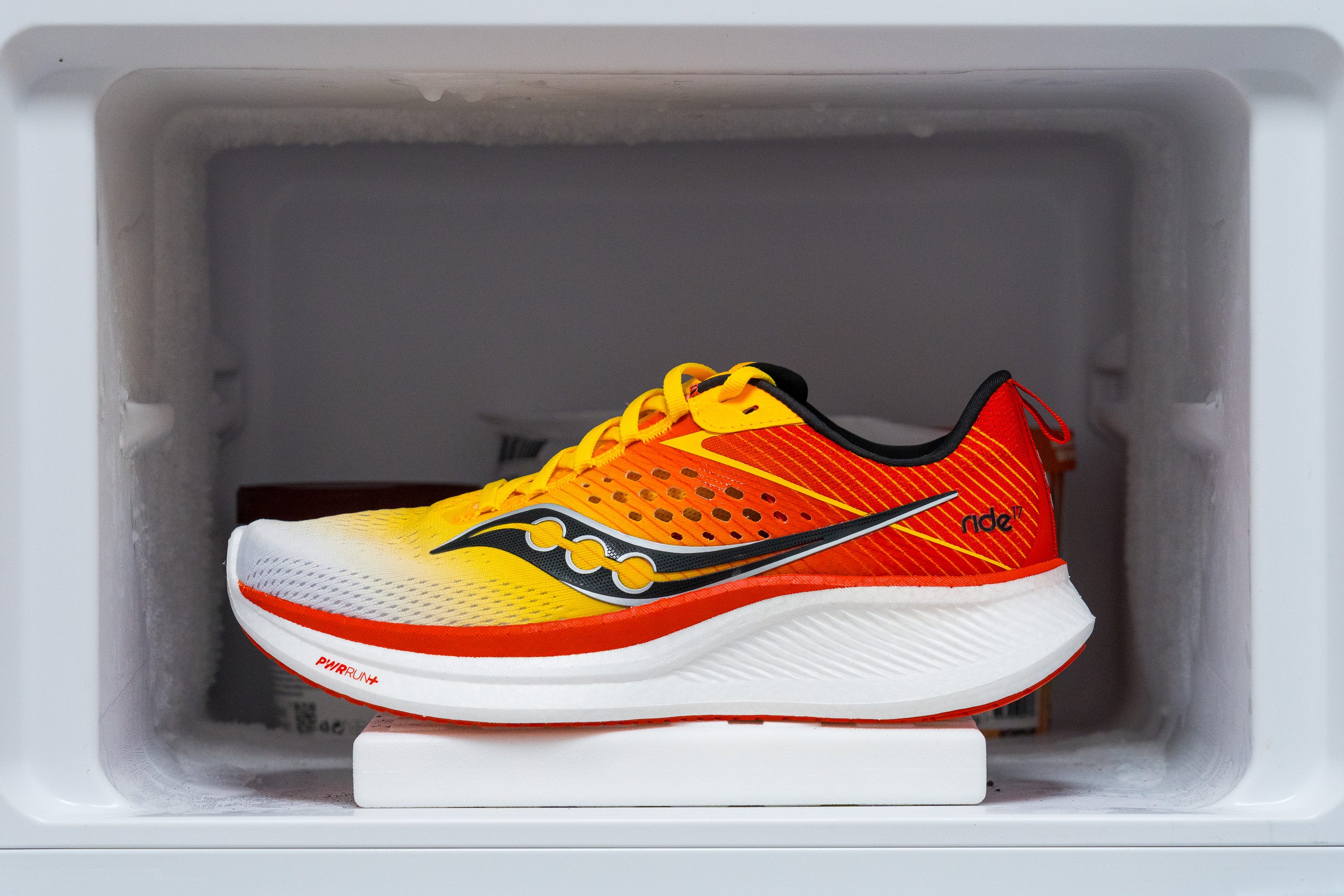
Midsole softness in cold (%)
In colder conditions, the TPU-based PWRRUN+ foam becomes just 20.4% stiffer—a result that's quite favorable, especially in a £140 shoe.
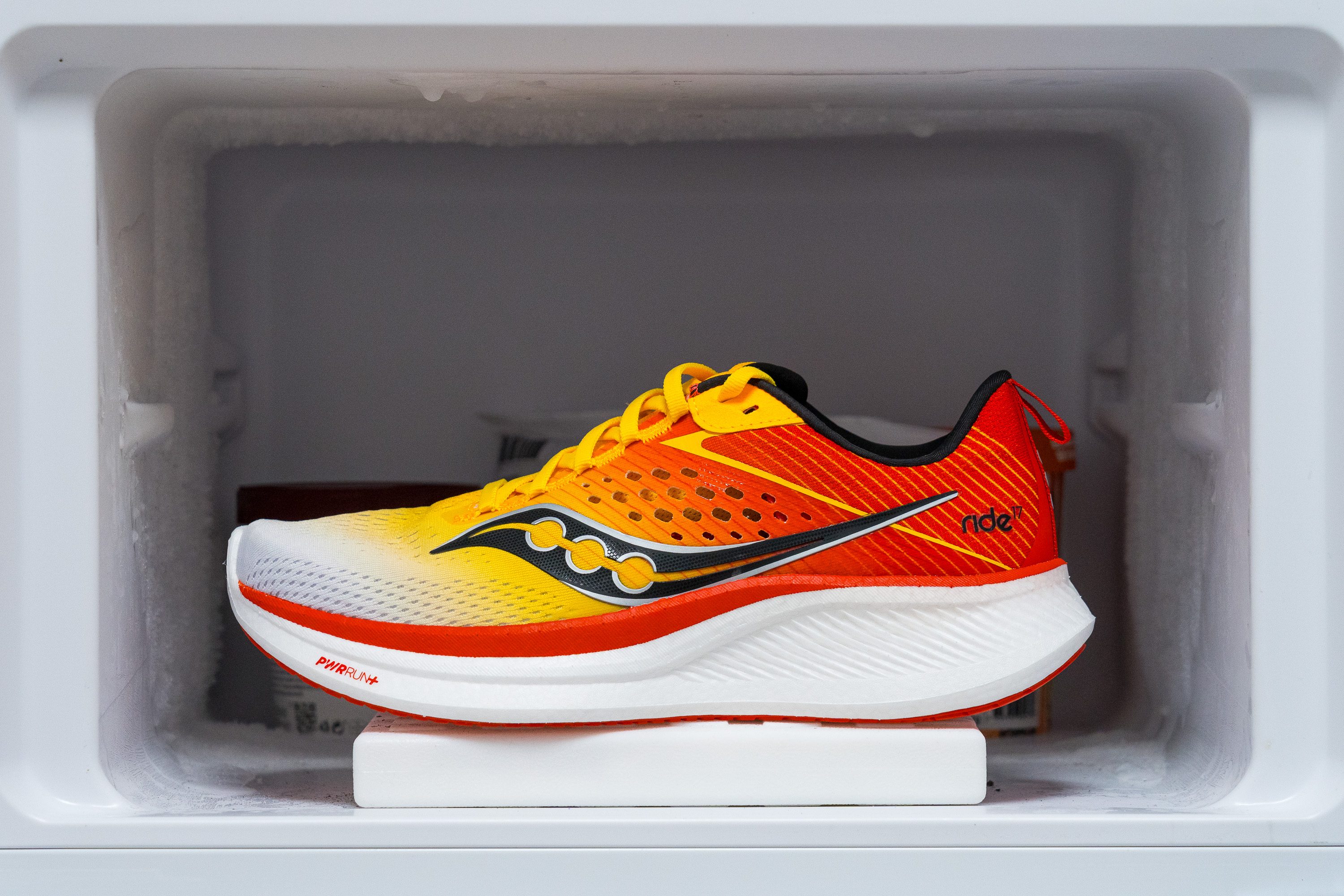
| Ride 17 | 20% |
| Average | 24% |
Reflective elements
Yes! The Ride 17 boasts reflective elements that enhance safety during post-sunset runs.
| Ride 17 | Yes |
Tongue padding
The tongue boasts an impressive 9.0mm of padding, ensuring superb comfort.
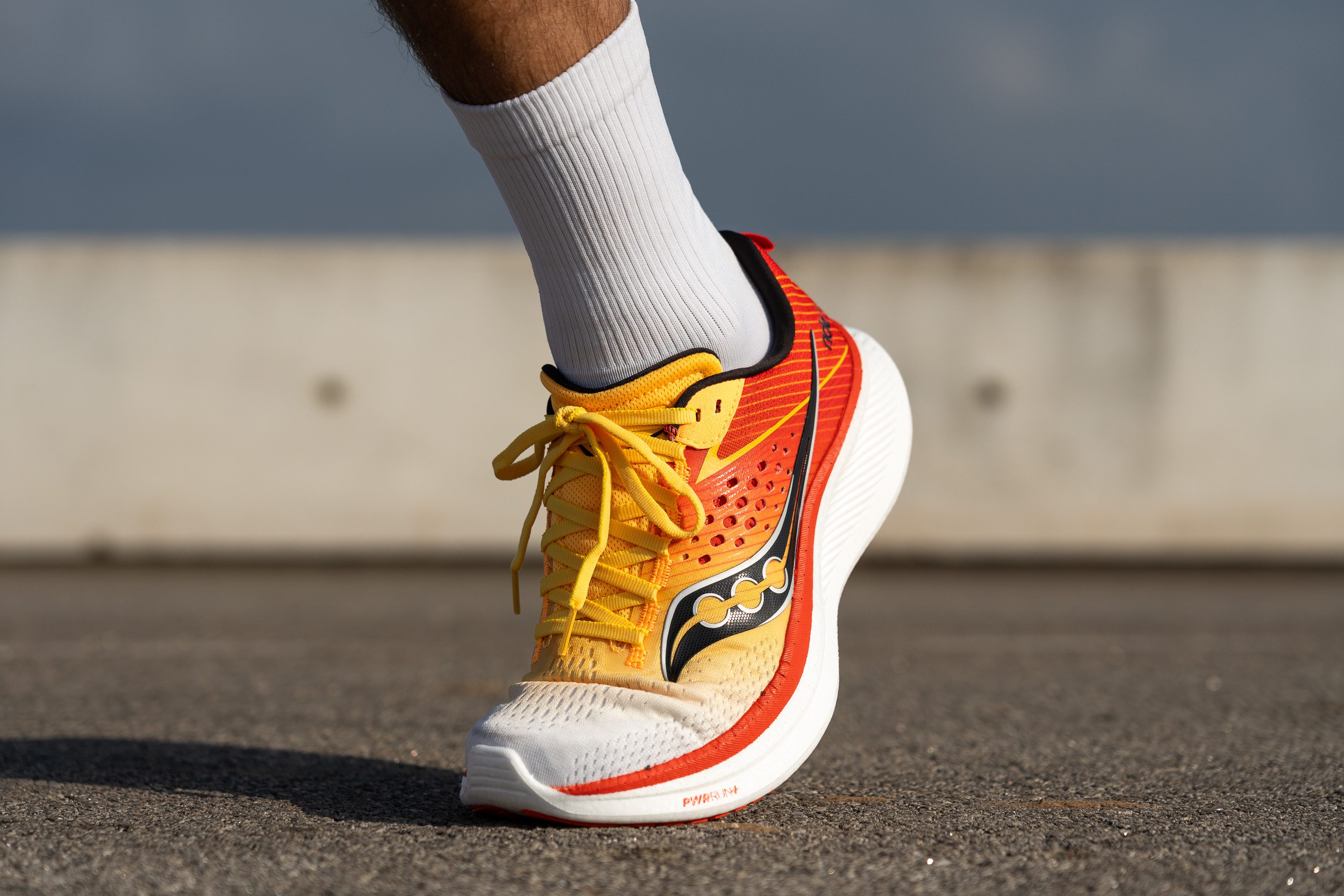
It's equipped with a full slab of foam that, in our experience, completely eradicates lace bite—no matter how tightly you tie your laces or how far you run.
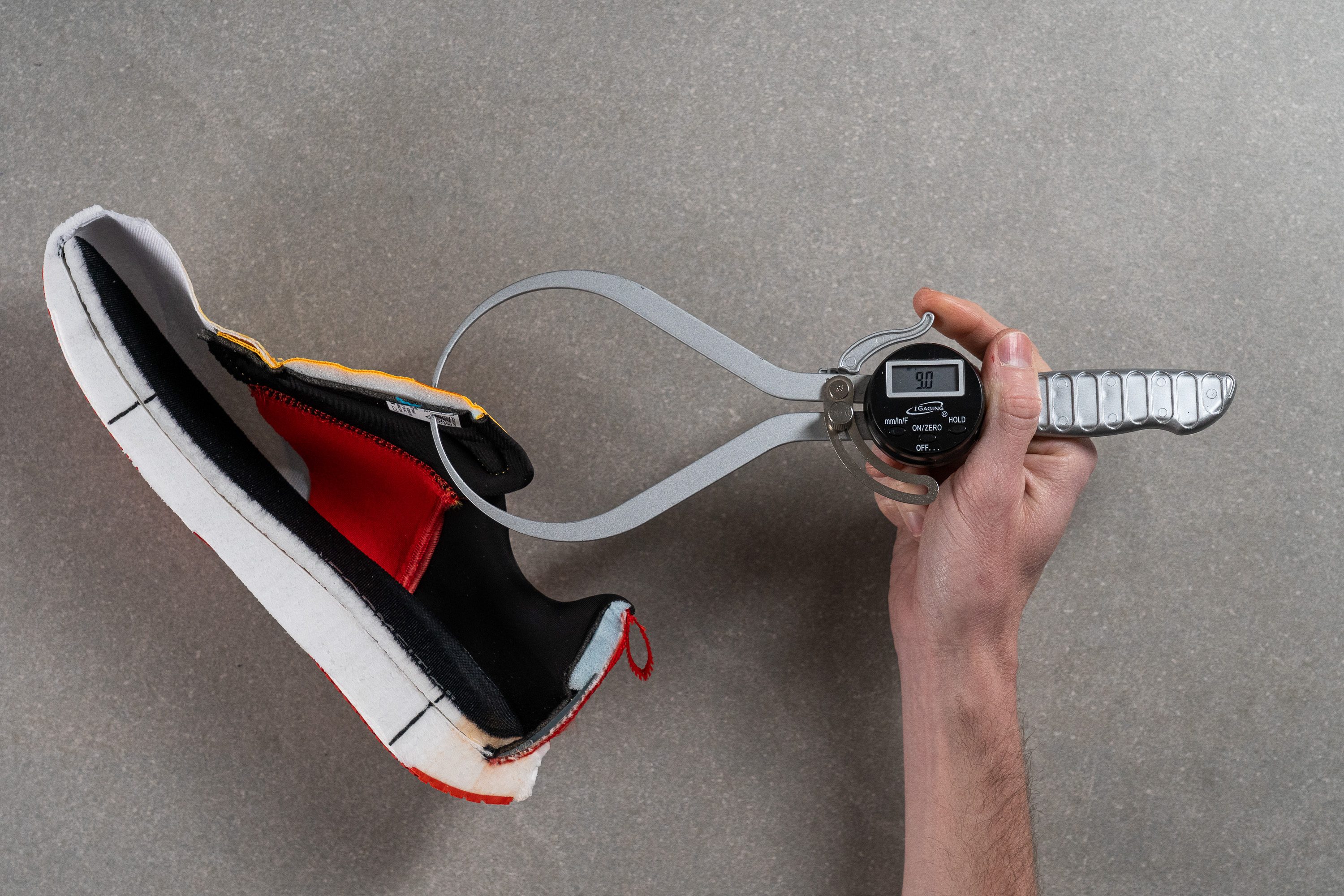
| Ride 17 | 9.0 mm |
| Average | 5.8 mm |
Tongue: gusset type
Upon our initial inspection of the tongue, we were delighted to discover it's semi-gusseted—a superb feature for a daily trainer like this, and absolutely a must for wide toeboxes.
This feature is a real plus, especially considering not every shoe priced at £140 offers this.
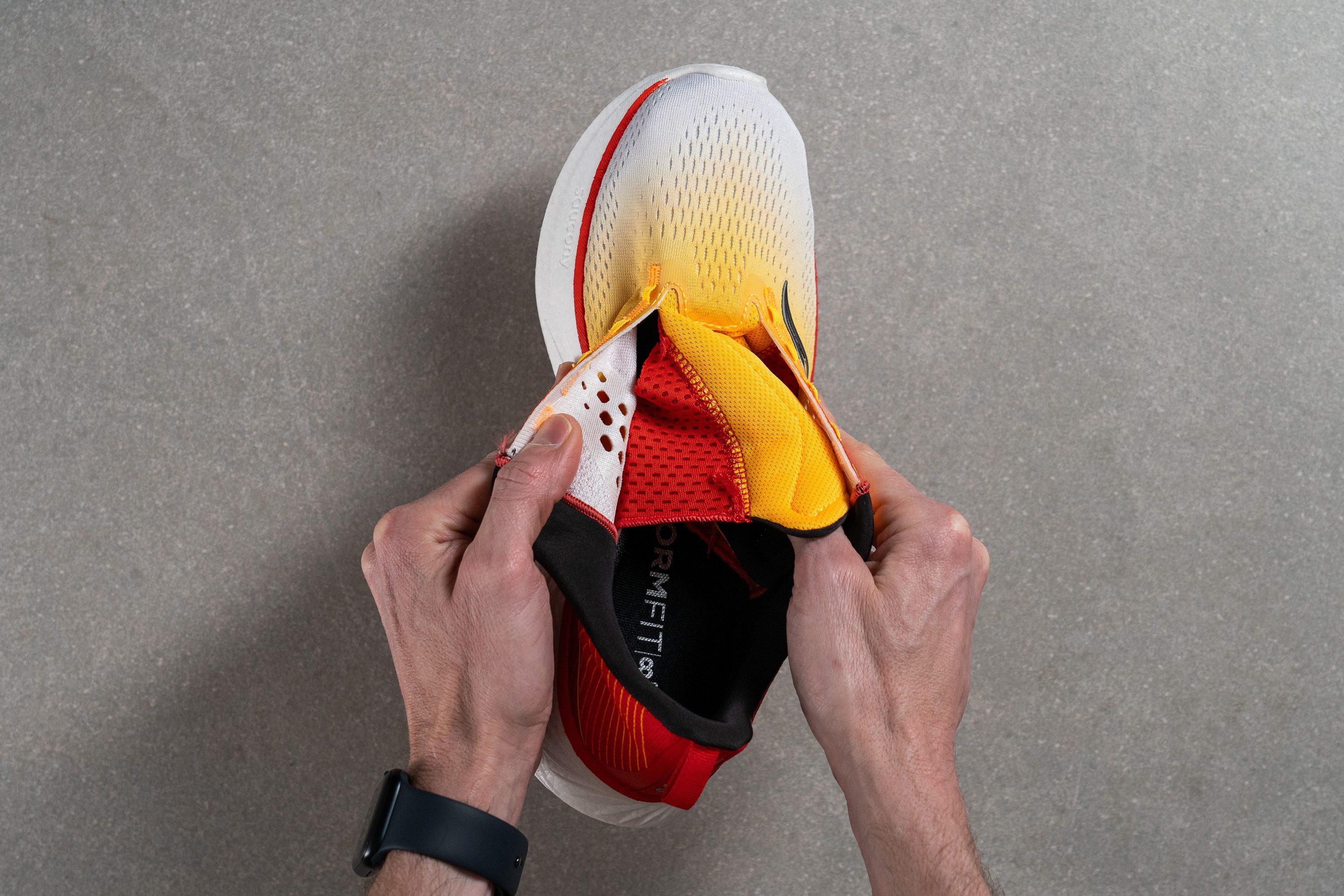
| Ride 17 | Both sides (semi) |
Heel tab
The Ride 17's heel features a finger-loop tab, intended for easier foot entry. However, this design not only appears kinda cheap and tear-prone but also makes it challenging to hook a finger through the loop.
We believe a more robust, premium heel tab would significantly improve the next Ride—something akin to the ASICS Superblast.

| Ride 17 | Finger loop |

